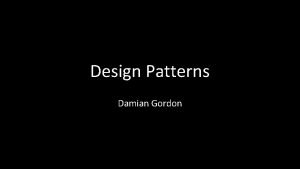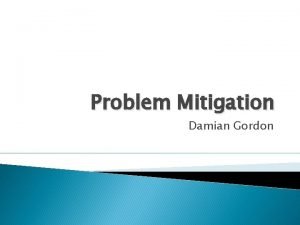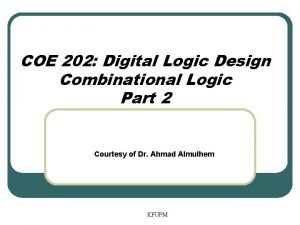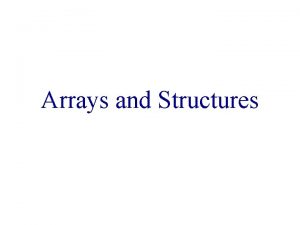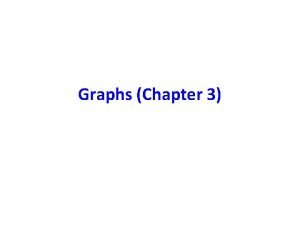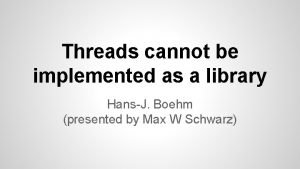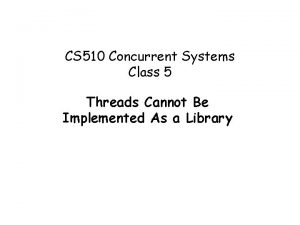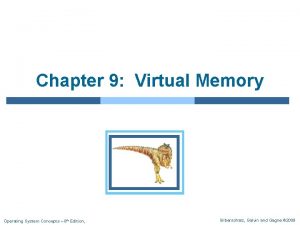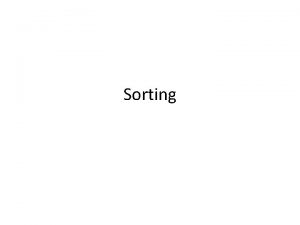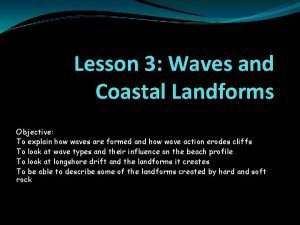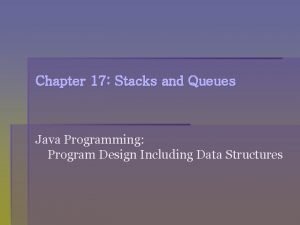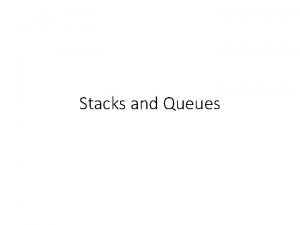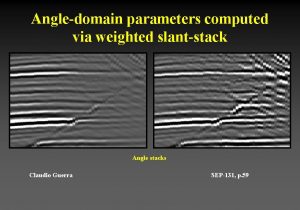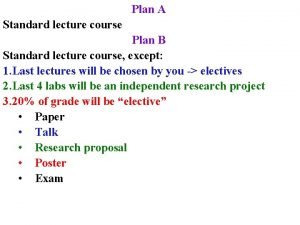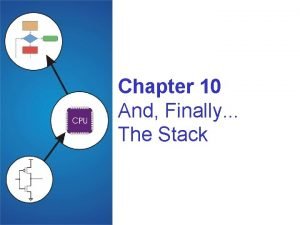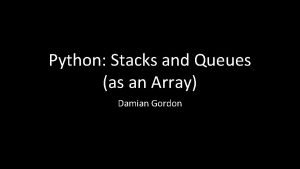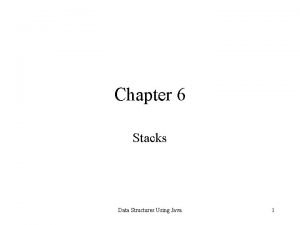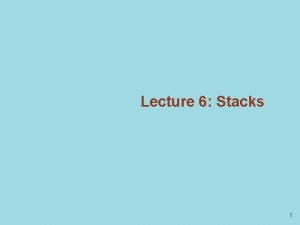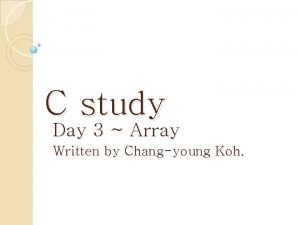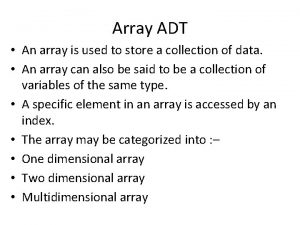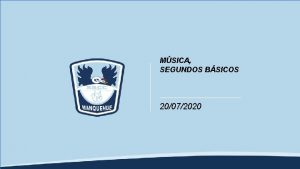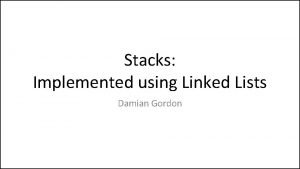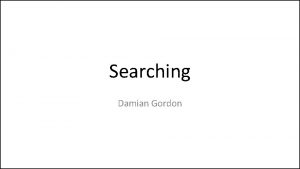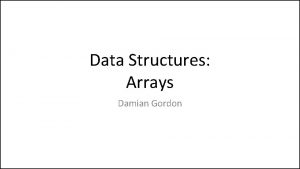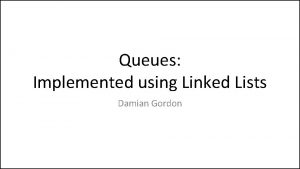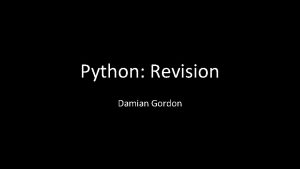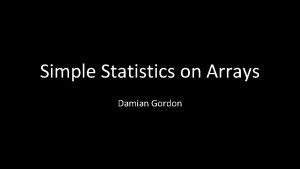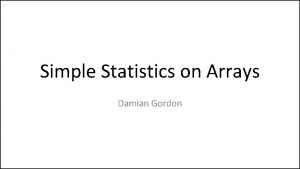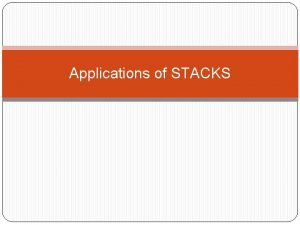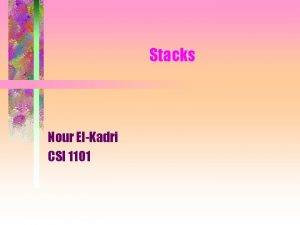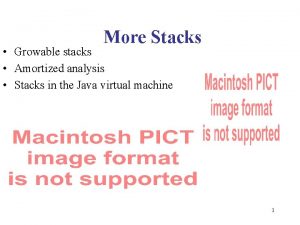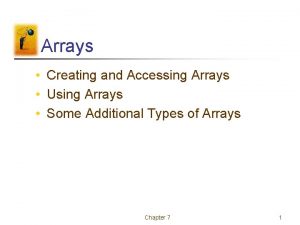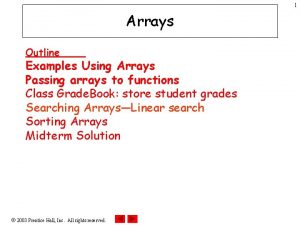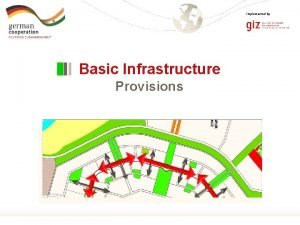Stacks Implemented using Arrays Damian Gordon Stacks A





















![Stacks PROGRAM Implement. Stack: Integer Stack[7] <- {31, 41, 59, 26, 53, 59, 67}; Stacks PROGRAM Implement. Stack: Integer Stack[7] <- {31, 41, 59, 26, 53, 59, 67};](https://slidetodoc.com/presentation_image_h/2d8206f838a3aa243daab5321344042b/image-22.jpg)














- Slides: 36

Stacks: Implemented using Arrays Damian Gordon

Stacks • A Stack is a pile of stuff:

Stacks • A Stack is a pile of stuff: • It’s a structure that conforms to the principle of Last In, First Out (LIFO). • The last item to join the stack is the first item to be served.

Stacks 59 53 26 59 41 31

Stacks 59 53 26 59 41 31 Top Bottom

Stacks • Values are added to the top:

Stacks • Values are added to the top: 67 59 53 26 59 41 31

Stacks • Values are added to the top: 67 59 53 26 59 41 31

Stacks • Values are added to the top: 67 59 53 26 59 41 31

Stacks • Values are removed from the top: 67 59 53 26 59 41 31

Stacks • Values are removed from the top: 67 59 53 26 59 41 31

Stacks • Values are removed from the top: 59 53 26 59 41 31

Stacks • We will implement a stack as an array called Stack. • The maximum length of the stack is called Max. Size. • The current top of the stack is called Stack. Top.

Stacks • We will implement a stack as an array called Stack. 0 1 2 3 4 5 6 31 41 59 26 53 59

Simple Simulation

Stacks • We will implement a stack as an array called Stack. 0 1 2 3 4 5 6

Stacks • We will implement a stack as an array called Stack. 0 1 2 3 4 5 6

Stacks • We will implement a stack as an array called Stack. 0 1 2 3 4 5 6

Stacks • We will implement a stack as an array called Stack. 0 1 2 3 4 5 6

Stacks • We will implement a stack as an array called Stack. 0 1 2 3 4 5 6

End of Simulation
![Stacks PROGRAM Implement Stack Integer Stack7 31 41 59 26 53 59 67 Stacks PROGRAM Implement. Stack: Integer Stack[7] <- {31, 41, 59, 26, 53, 59, 67};](https://slidetodoc.com/presentation_image_h/2d8206f838a3aa243daab5321344042b/image-22.jpg)
Stacks PROGRAM Implement. Stack: Integer Stack[7] <- {31, 41, 59, 26, 53, 59, 67}; Integer Max. Size <- 7; Integer Stack. Top <- 6; END.

Stacks • We will look at implementing the following modules: • Is. Full() – Check if the stack is full • Is. Empty() – Check if the stack is full • Push(N) – Add a new item (N) to the top of the stack • Pop() – Remove the top value from the stack • Top() – Tell us what the top value of the stack is (without removing it).

Stacks • Is. Full() – If Stack. Top + 1 = Max. Size 0 1 2 3 4 5 31 41 59 26 53 6

Stacks MODULE Is. Full(): Boolean Full; IF Stack. Top + 1 = Max. Size THEN Full <- True; ELSE Full <- False; ENDIF; RETURN Full; END.

Stacks • Or MODULE Is. Full(): RETURN Stack. Top + 1 = Max. Size; END.

Stacks • Is. Empty() – If Stack. Top = 0 0 1 2 3 4 5 31 41 59 26 53 6

Stacks MODULE Is. Empty(): Boolean Empty; IF Stack. Top = -1 THEN Empty <- True; ELSE Empty <- False; ENDIF; RETURN Empty; END.

Stacks • Or MODULE Is. Empty(): RETURN Stack. Top = -1; END.

Stacks • Push(N) – Add 1 to Stack. Top = 0, and write N into that location. 0 1 2 3 4 5 31 41 59 26 53 6

Stacks MODULE Push(N): IF Is. Full() = True THEN Print “Stack is Full”; ELSE Stack. Top <- Stack. Top + 1; Stack[Stack. Top] <- N; ENDIF; END.

Stacks • Pop() – Write out the value at Stack. Top, and take 1 away from Stack. Top. 0 1 2 3 4 5 31 41 59 26 53 6

Stacks MODULE Pop(): N <- 0; IF Is. Empty() = True THEN Print “Stack is Empty”; ELSE N <- Stack[Stack. Top]; Stack. Top <- Stack. Top - 1; ENDIF; RETURN N; END.

Stacks • Top() – Write out the value at Stack. Top. 0 1 2 3 4 5 31 41 59 26 53 6

Stacks MODULE Top(): N <- 0; IF Is. Empty() = True THEN Print “Stack is Empty”; ELSE N <- Stack[Stack. Top]; ENDIF; RETURN N; END.

etc.
 Damian gordon
Damian gordon Damian gordon
Damian gordon Index.of.secret
Index.of.secret Coe 202
Coe 202 Polynomial representation using array in c
Polynomial representation using array in c Virtual and datagram networks
Virtual and datagram networks Strongly connected components
Strongly connected components Who implemented glasnost and perestroika
Who implemented glasnost and perestroika Threads cannot be implemented as a library
Threads cannot be implemented as a library Packet switching system
Packet switching system Threads cannot be implemented as a library
Threads cannot be implemented as a library Virtual memory is commonly implemented by
Virtual memory is commonly implemented by Topological sort can be implemented by?
Topological sort can be implemented by? Bombay nursing home registration
Bombay nursing home registration Economic adviser of manuel roxas
Economic adviser of manuel roxas How to prevent buffer overflow in c
How to prevent buffer overflow in c Non financial criteria for project selection
Non financial criteria for project selection Windowok inc implemented a new pay policy
Windowok inc implemented a new pay policy Speed stacks spreads nationally in 1998.
Speed stacks spreads nationally in 1998. Wave cut notch diagram
Wave cut notch diagram Java stacks and queues
Java stacks and queues What are stacks
What are stacks Two-stack pda examples
Two-stack pda examples Angle stacks
Angle stacks ро
ро Types of stacks
Types of stacks Stacks+routined
Stacks+routined Empty python
Empty python Data structures using java
Data structures using java 6 stacks
6 stacks Stacks internet
Stacks internet Five ocean basins
Five ocean basins Java stack exercises
Java stack exercises Day 3: arrays
Day 3: arrays Damian clancy
Damian clancy Arrays as adt
Arrays as adt Padre damian de veuster 2215 vitacura
Padre damian de veuster 2215 vitacura
